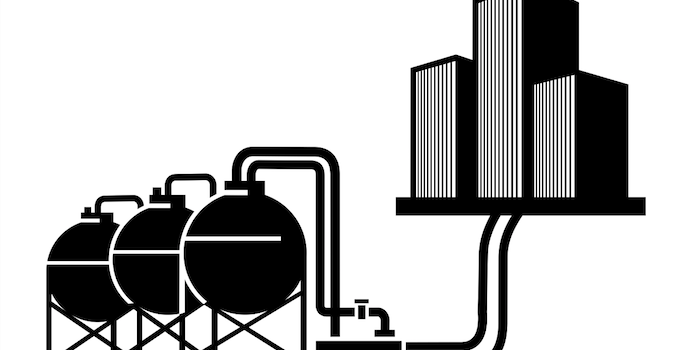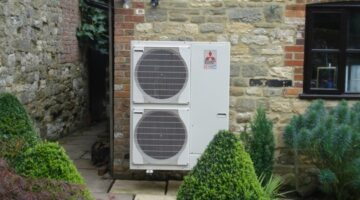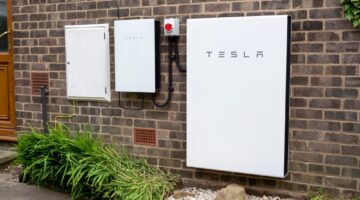
Also known as heat networks, district heating systems generate heat in a centralised location and distribute it amongst multiple different buildings. They can be used to provide space or water heating for residential or commercial requirements. The idea is to provide low-carbon energy cheaply. If the central heating generator is a renewable technology, and ‘waste’ heat is incorporated from other sources, it can be a highly efficient and green heating option.
Is communal heating the same as district heating?
Let’s start with a common question. To the layman they may seem very similar, but there is one simple difference between the two, and that’s scale. Communal – or ‘community’ – heating usually only services one or two buildings in close proximity to one another – a block of flats or an estate, for example. District heating is on a larger scale, with properties often miles apart being serviced by the same heat network. It may seem semantic, but practically it makes a difference; community heating tends to be from gas boilers or CHP, whereas district heating is more likely to use waste heat from large infrastructure, or use waste products or biomass. There is also an infrastructure step-up in transporting heat and hot water to buildings that are not necessarily close together.
For the purpose of this blog, however, let us assume that they are similar, as there are many different systems like this with plenty of grey areas between them.
How does district heating technology work?
Power is normally produced by a centralised system, whether that be biomass, CHP, or in smaller systems, gas or oil boilers. Older systems will use a simple fossil fuel boiler(s) to heat water, which is then pumped around the building(s). This is simple and effective, and because of the centralised generation will be less carbon-intensive than individual boilers.

Modern district heating is all about reducing waste by distributing residual heat that is generated during the day, rather than just during peak morning and evening times, when demand is at its highest. For instance, in the daytime, heat can be recovered from air-conditioned offices and used to heat swimming pools. Other district heating systems capture free waste heat from train tunnels, helping to subsidise heating bills for people connected to the network.
Future of district heating for the UK
Some European countries provide a large majority of their energy from district heating. But now district heating is becoming more common in the UK, especially as part of new-build housing developments. Around 210,000 UK households are currently connected to district heating networks. There is a new one planned for London using waste heat from tube stations.
The main issue with district heating, however, is that it’s much easier to plan before building than retrofitting. It also requires the estate management to persuade a lot of residents that it would be a good idea and that they wouldn’t be left carrying the cost of installation.
All in all, district heating is a great idea, but quite hard to get right in practice. There are several problems that make it hard to retrofit on a wider scale in the UK.
What do we see as common problems with district/communal heating?
As a company that has met many occupants of communal heating schemes, we can give you some experiences of communal/district heating. One of the main concerns that we hear is not over the heating per se, but controlling the heating. For those on flat-rate charging (i.e. paying the same rate for their heating, however much they use), there is a tendency to open a window rather than turn down the thermostat, and heat rooms much higher than you would if you were the one paying the bill. Beyond that, especially in older systems, there tends to be very poor control of the heating in general. Where many modern homes have programmers, thermostats and thermostatic values, some flats in buildings with communal heating have just one or two of these, if at all. This can again lead to overheating and the wasting of energy.
The ideal scenario is to have district heating with metering, which allows charging based on how much energy the customer uses. You would be surprised how rare this is, largely because there is a great deal of push-back from customers who already have flat rate charging and don’t want their bills to go up. For the company running the heating, flat rate charging allows a guaranteed income, which is often over the odds when the price per unit is considered, and penalises customers that make the effort to reduce their use. It can be expensive to convert an old system that uses flat rate charging, and so with this lack of will from both sides, it can be tricky to change.
Benefits
- Higher efficiency, especially if using CHP plants, which generate electricity and gas simultaneously.
- Lower carbon emissions than individual boilers.
- Gives the opportunity for smaller dwellings to use alternative clean and renewable fuels like biomass that would otherwise be unsuitable for their property.
Limitations
- Requires forward-planning, as difficult to retrofit.
- Requires long-term financial commitment – there is no quick return on the investment, so it could be difficult to sell to homeowners.
- Connecting homes to a district heating system means residents can’t change supplier down the line – so they won’t necessarily be getting the cheapest deal.
- District heating system providers aren’t subject to OFGEM regulations, so there’s no consumer protection or minimum standards of service for customers. Breakdowns and service interruptions are taken out of the occupants’ hands.
- Controls and tariffs need to be carefully considered to create the most efficient solution.
Think we missed something? Do you have a different opinion?
Comment below to get your voice heard…












No Comments yet! Be the first one.